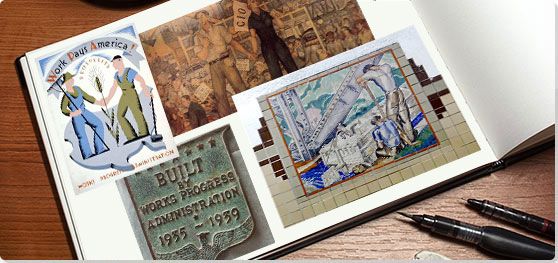Summary of Federal Art Project of Works Progress Admin
During its years of operation, the government-funded Federal Art Project (FAP) of the Works Progress Administration (WPA) hired hundreds of artists who collectively created more than 100,000 paintings and murals and over 18,000 sculptures to be found in municipal buildings, schools, and hospitals in all of the 48 states. Additionally, nearly 100 community art centers throughout the country provided art classes for children and developing artists. The FAP was part of President Franklin Roosevelt's New Deal during the Great Depression, in which he sought to put as many unemployed Americans back to work as possible and to buoy morale of the citizens. Some of the 20th century's greatest visual artists were employed by the FAP, along with many nascent Abstract Expressionists.
Key Ideas & Accomplishments
- One of the main aims of the Federal Arts Project was to invoke familiar images that spoke of shared values and American progress, including technological wonders, fertile farmlands, small town life, and big city vibrancy. Additionally, the program hoped to foster the role of the arts in public life and to bring the artist closer to everyday, American life.
- The Federal Art Project tended to favor more realistic styles, including Social Realism and Regionalism, although many of the younger painters were able to execute more abstract work in some of the mural designs. The FAP allowed many artists for the first time to work exclusively as artists without taking up side jobs, and it brought the art they created in a variety of styles to communities and cities around the country through murals, easel paintings, photographs, posters, and sculptures.
- One of the most consequential aspects of the Project, according to the younger artists involved, with the sense of community that it fostered. By picking up their paychecks every week at the FAP office and getting to know each other as well as working on mural teams, artists no longer felt isolated and instead a camaraderie began to develop. Without this sense of community, it is hard to imagine the formation of Abstract Expressionism, one of the most significant groups in American modern art.
The Important Artists and Works of Federal Art Project of Works Progress Admin
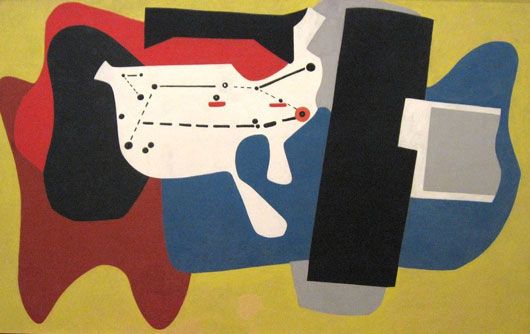
Aerial Map
Aerial Map is one of two surviving murals that Gorky painted for Newark Airport's Administration Building. Originally ten murals comprised the cycle, entitled Aviation: Evolution of Forms under Aerodynamic Limitations. Drawing on his study of Pablo Picasso and Fernand Leger, Gorky's composition relies on bold colors and simple, superimposed shapes to convey a sense of the terrain that one would see from the air or perhaps the shape of the airport itself. The short black dashes and dots in the white shape at the center of the canvas, which roughly resembles the outline of the United States, call to mind flight routes that one would map out. While Gorky's mural was controversial at the time because of its abstract nature, Gorky insisted that an art of the future was necessary to depict the transportation of the future.
The murals were painted over when the airport was turned into a military base during World War II. They were thought lost, but in 1972 they were rediscovered, concealed under fourteen coats of paint that had been applied over the years as part of regular maintenance. Two of the panels were recovered and restored and now on view at the Newark Museum.
Oil on canvas - Newark Museum
Untitled (The Subway)
Here, Mark Rothko depicts the eerily quiet and still interior of a subway station. The space is punctuated by evenly spaced columns that recede quickly into the background. The people depicted do not interact or speak with one another. The women on the bench, with their fancy hats and pointy shoes, are completely self-involved. The man who stands near the platform edge practically melds with the column he stands near. Rothko thus captures the isolation and loneliness that can befall one in a big city.
Untitled (The Subway) is probably one of the more realistic paintings Rothko created before he evolved to paint large abstract canvases with floating, sometimes translucent, rectangles stacked on top of each other. Even in this early painting, though, one can see the way in which Rothko manipulates color and space to evoke human emotions, an aim that he carried throughout his artistic career.
Oil on canvas - Private Collection
Cotton Pickers
Few of Pollock's paintings that he created for the FAP survived, and those that do, like Cotton Pickers, have fairly traditional subject matter. Here, Pollock depicts the laborers, shielded from the sun in large hats and long sleeves, doing the back-breaking work of picking cotton. Pollock presents the plight of the workers in a sympathetic light. Solidarity with other impoverished workers was a staple of much WPA work.
The curves of the laborer's bodies and their simplified forms call to mind the style of Pollock's mentor, Thomas Hart Benton. Benton was a proponent of Regionalism and American Scene painting, which focused less on urban scenes and more on Midwest small town and farming communities. Combining this subject matter with some of the more abstract forms of modern European art, Benton forged a uniquely American art that Pollock quickly mastered and surpassed.
Oil on canvas - The Albright-Knox Gallery
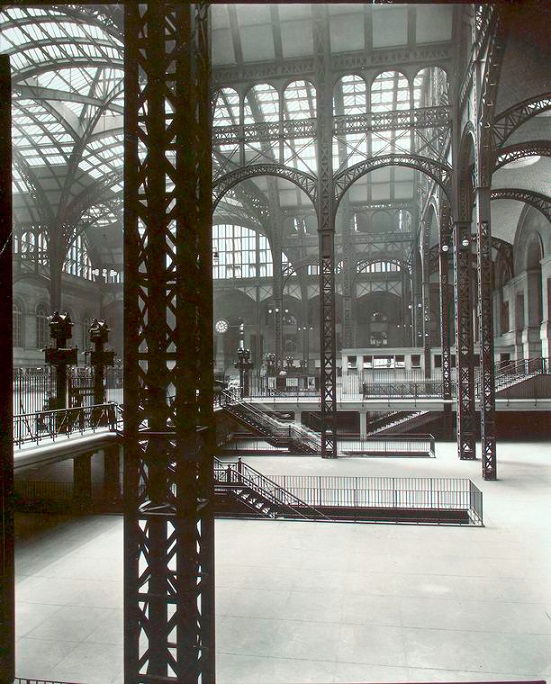
Penn Station, Interior, Manhattan
In this image, the renowned photographer Berenice Abbott captures the soaring structure of the original Pennsylvania train station in the heart of New York City. Steel girders rise high into the air, supporting massive arches, and the interior is sunlit with countless windows held in place by the steel structure. With this composition, Abbott celebrates the grandeur of technology, transportation, and ultimately New York City.
Abbott arrived in New York City in 1929 and immediately began taking photographs of her new environment. It was only in 1935 that she was able to get funding from the FAP for her series. She was made the supervisor of her own project, "Changing New York," and was assigned assistants. With the series, she aimed to document the diverse city population, their public and private environments, and their daily activities. She hoped that people would be able to visualize their daily lives and realize that their collective behavior contributed to their environment and vice versa. Abbott combined what was basically a sociological study with modernist photographic aesthetics, using sharp angles and eschewing traditionally "pretty" compositions to create an image of a city on the edge of transformation.
Photographic print - Collection of the New York Public Library

Roosevelt/Jersey Homestead Mural
In this mural, Shahn depicts the journey and struggles of the Jewish immigrants from Germany and Eastern Europe to America. Using a montage composition, Shahn shows on the far left German soldiers and Ellis Island, signaling the arrival of the Jewish immigrants, including Albert Einstein and Shahn's own mother, and on the right, their entry into factory sweatshops and tenements. The second panel depicts their involvement in the trade union movement, with the infamous Triangle Shirtwaist Factory, the scene of a horrific fire in 1911 that killed almost 150 garment workers, in the background. The third panel shows the evolution of the labor movement to the planning and development of Jersey Homestead (now Roosevelt, NJ), a cooperative of factories and farms.
Influenced by the Mexican muralist Diego Rivera, Shahn employed a Social Realist style to depict the struggles of industrial laborers and promote class and community consciousness. The juxtaposition of images and various perspectives give a sense of the complexity of the industrialized system and the myriad of people who live in urban centers. The facial expressions and gestures of the individuals Shahn depicts suggest the acute need for activism. Shahn hoped that his art would inspire the laborers who saw his depictions of their plight to fight for the workplace reforms that were desperately needed.
Fresco - US Post Office in Camden, NJ
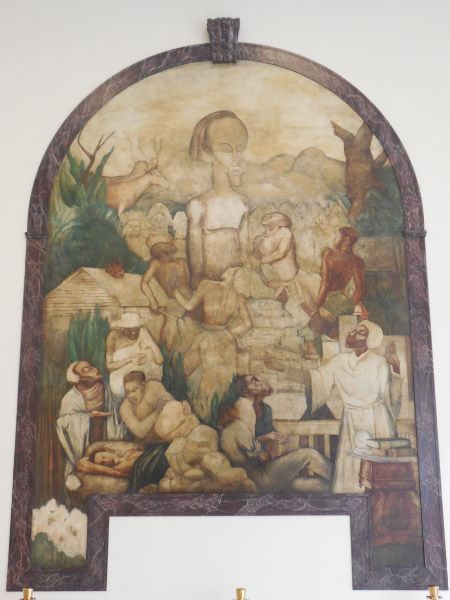
Magic and Medicine
In this large-scale painting Alston depicts traditional healing practices from Africa, where, traditionally, illness was thought to be an indication of spiritual imbalance. The panel is paired with his other mural Modern Medicine, a panel which depicts new technology and both White and Black doctors. The diptych suggests the place of both spirituality, or faith, and reason and science. At the top of the mural, the landscape and flora and fauna of Africa dominate the composition. Alston included a representation of a Fang reliquary sculpture from the central African country of Gabon. Such sculptures were collected by his contemporaries, and the simplified forms and shapes of such sculpture influenced countless modern European and American artists. Other ritual objects such as drums and statuary can be found throughout the composition. The robed female figure in the bottom right corner of the canvas represents a spiritualist and healer distributing herbal medicines and traditional cures. Alston's use of sepia tones gives the whole composition a feeling of bygone eras.
In 1936, Alston became the first African-American artist given a supervisory role on the FAP. He oversaw these and other murals at the Harlem Hospital. His own murals, though, were deemed controversial in their prominent display of African and African American subject matter, despite the fact that FAP encouraged community-centered subjects. After much protest, including a letter to President Roosevelt, Alston was allowed to install his murals in 1940.
Oil on canvas - Harlem Hospital, New York City
History of the Project
The Origins
In the mid 1930s, the United States remained at the center of a global economic depression. In an effort to provide economic relief to citizens who were having trouble finding work President Franklin Delano Roosevelt established the Works Progress Administration. Several months later, a subdivision of the WPA called the Federal Art Project was developed in order to assist struggling artists.
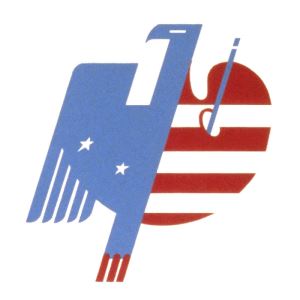
Prior to the creation of the FAP, Roosevelt made other attempts to provide relief for artists, including the Public Works of Art Project (PWAP), which only lasted a year, from 1933 to 1934. The Treasury Department Section of Painting and Sculpture was created in 1934 after the PWAP was dissolved, but it too was unsuccessful.
For artists to be considered for the Federal Art Project, they first had to apply for Home Relief to confirm that they were impoverished and then submit samples of their work to demonstrate they were actively creating art. Once approved, an artist's stipend was about $24 per week.
Only a few months after the Federal Art Project was announced, more than 1100 artists were working for the WPA, including artists such as Stuart Davis, Jackson Pollock, and Arshile Gorky.
The Divisions of the FAP
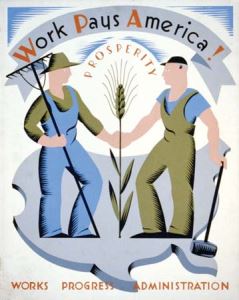
Within the FAP, an artist could work on any number of divisions. A large number of artists, including Willem de Kooning, Ilya Bolotowsky, Ben Shahn, and Arshile Gorky, worked in the mural division. Murals were designed by one or two artists for a specific place and then executed by a team of artists. Often the murals were created in situ, but just as common was to paint the murals on large canvases that would then be installed at the site. Many of the artists who worked on the FAP murals looked to the Mexican Muralists Diego Rivera, José Clemente Orozco, and David Siqueiros. Their painting techniques as well as their social and political subject matter greatly influenced the younger generation of artists. Other artists, including Mark Rothko and Jackson Pollock, worked on the easel division. These artists would create individual paintings of their own design and composition in their personal studios and deliver one or two of them every four weeks to the WPA office. There were also divisions devoted to photography, print making, hand crafts, and graphic design.
The Early Years
The curator and arts administrator Holger Cahill was chosen to direct the FAP, overseeing art research, instruction, and production. Artists began creating easel pictures, murals, theater sets, photographs, and posters, and community art centers began to open. The art research arm of the FAP culminated in the massive Index of American design, which presented a comprehensive study of American material culture. Almost 18,000 decorative objects in museums and private collections from the colonial period through the 19th century were rendered in watercolors by hundreds of artists around the country. The illustrations were exhibited across the country and a selection was finally published in 1950.
On December 27, 1935, the WPA opened the Federal Art Project Gallery at 225 West 57th Street in New York City. Included in one of its first exhibitions were rare watercolors by Jackson Pollock. Cahill understood the need to have this federally funded art legitimized by the mainstream art world. To that end, he employed his wife, Dorothy Miller, who was a curator at the Museum of Modern Art, to organize an exhibition of works made during the first year of the FAP. "New Horizons in American Art" opened at MoMA in the fall of 1936.
While Willem de Kooning had been employed as a window designer for a shoe store, he quit his job and eventually found his way into the mural division of the FAP in late 1935. In typical fashion, de Kooning forged life-long and consequential relationships. Here he met the then poet, soon to be critic, Harold Rosenberg, who at the time was working as an assistant to muralist Max Spivak. Mural painters worked in teams, usually with one artist preparing the design and others executing it, sometimes in situ but often on panels that were then transported to the site. In contrast, the painters on the easel division worked alone in their studios, and they were required to bring a new oil painting to the FAP office every four to six weeks.
By 1936, the FAP employed around 6000 artists. While on the Project, many artists, like Adolph Gottlieb, also joined the Artists' Union, which acted in the artists' interests in bargaining with the government and supported artists who were fired. In subsequent years, Mark Rothko submitted a series of figurative portraits for another subdivision of the WPA, the Treasury Relief Art Project, including Untitled (Two Women at the Window) (1937) and Untitled (Subway) (1937) before joining the easel division.
In the summer of 1937 the U.S. government announced that all WPA workers had to be legal U.S. citizens. This edict meant that Mark Rothko (Latvian), Arshile Gorky (Armenian) and Willem de Kooning (Dutch) could no longer legally participate in the FAP, although it would take some time for the federal government to track down all non-citizen WPA workers. Gorky and Rothko continued to work after the late-summer announcement, but De Kooning, fearing deportation, resigned from the WPA.
The Last Years Prior to World War II
In the later 1930s, there was increasing concern (largely unfounded) among conservative politicians of Communist infiltration in the FAP. Many artists were baselessly accused of being Communists, and they were required to sign a loyalty oath. In January 1939, the Federal Art Project began laying off some of its artists. Within that same year, Arshile Gorky became an American citizen and once again was eligible to receive FAP relief, but Mark Rothko (still a non-U.S. citizen) was dropped from the roles on August 17th.
The WPA Dissolves
As the U.S. entered World War II, many of the arts related divisions were incorporated into the war services division and refocused their production to creating camouflage, designing training manuals and pamphlets, and teaching art appreciation classes on military posts. Within a year of going to war, on June 30th, the Federal Art Project disbanded and ceased providing funds of any kind to artists.
In December 1943, the government auctioned off thousands of FAP-funded paintings in a warehouse in Queens. Paintings weren't sold individually, but by the pound. Reportedly, a local plumber purchased a large number of paintings in bulk for the purposes of insulating pipes with used canvases, but he discovered that when the pipes got too hot, the melting paints produced an odd smell. Herbert Benevy, the owner of a local frame shop, also purchased a large number of paintings for $3 per canvas. Among those he bought were paintings by Milton Avery, Mark Rothko, and Jackson Pollock.
Legacy
In all, nearly 200,000 artworks were created under the Federal Art Project. And while many of those works have since become lost or were destroyed, much of the country was able to experience art in person for the first time, either in public places like post offices and apartment buildings or in community art centers where they also took classes and heard lectures. The FAP also demonstrated that art was worthwhile work and not a leisure activity to be pursued on the side. Perhaps its most enduring legacy, however, is that it fostered a group of young artists in New York City who would go on just a decade later to create some of the most powerful paintings of the 20th century. The artists of the FAP created enduring images of America's founding and progress that were wrapped into the nation's idealized narrative of its past and future potential, while also democratizing the ideas and the making of art.
Useful Resources on Federal Art Project of Works Progress Admin
- Art for the Millions: Essays from the 1930's by Artists and Administrators of the WPA Federal Art Project (1975)Our PickBy Francis V. O'Connor
- A New Deal for the Arts (1997)Our PickBy Bruce Bustard / In depth look at the arts initiative, based on the 1997 exhibit at the National Archives and Records Administration
- When Art Worked: The New Deal, Art and Democracy (2009)By Roger Kennedy / A summary of the objectives that put the WPA into action
